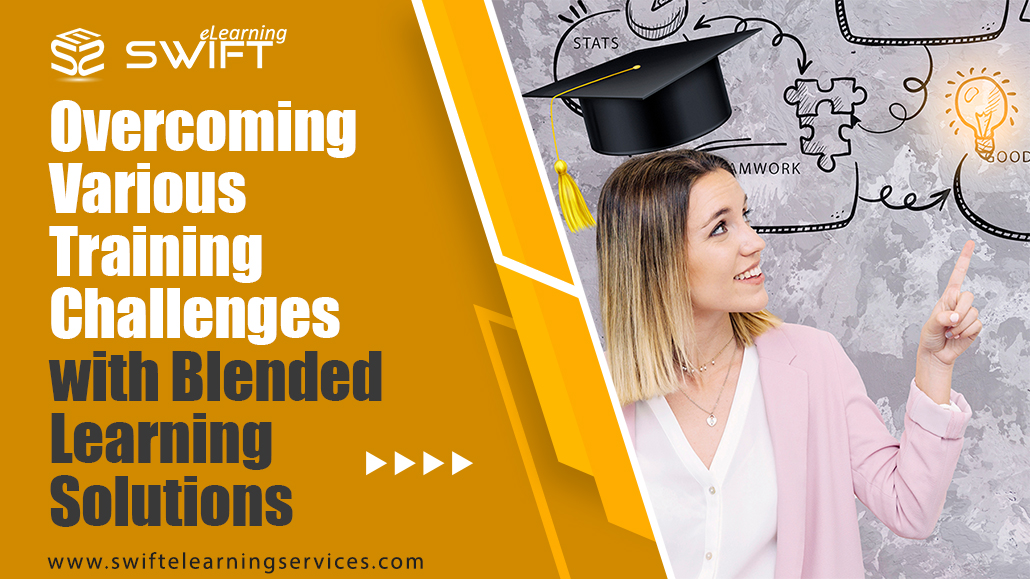Overcoming Various Training Challenges with Blended Learning Solutions
Overcoming Various Training Challenges with Blended Learning Solutions: Discover how blended online and offline training methods can address engagement issues, cater to different learning styles, and provide cost-effective solutions. Learn how blended learning enhances collaboration, flexibility, and knowledge retention for successful training outcomes.
In today’s fast-paced world, training and development have become critical components of organizational success. However, traditional training methods often fall short in meeting the diverse needs of learners. That’s where blended learning solutions come into play. By combining the best of both online and offline training methods, organizations can overcome various challenges and provide effective learning experiences.
In this article, we will explore the concept of blended learning and delve into how it can help overcome training challenges.
1. Understanding Blended Learning Solutions
Blended learning solutions refer to the integration of traditional classroom instruction with online learning experiences. It combines face-to-face interactions between teachers and students with technology-enabled activities, creating a hybrid approach to education. Blended learning has gained significant popularity in recent years due to its ability to provide a flexible and personalized learning experience for students.
One of the key advantages of blended learning is the ability to tailor instruction to meet individual student needs. By leveraging online resources and tools, educators can deliver content in various formats such as videos, interactive simulations, and multimedia presentations. This allows students to engage with the material at their own pace and revisit concepts as needed, promoting a deeper understanding of the subject matter.
Furthermore, blended learning offers opportunities for active learning and collaboration. Online platforms enable students to participate in discussions, work on group projects, and engage in virtual simulations or experiments. These interactive components foster a sense of community and encourage peer-to-peer learning, even when students are not physically present in the same location.
Blended learning also provides flexibility in terms of time and location. Students can access online resources and complete assignments at their convenience, which is particularly beneficial for individuals with diverse schedules or those who require a more self-paced learning environment. This flexibility is especially valuable in scenarios such as distance learning, where students may be located in different time zones or have limited access to physical classrooms.
Another significant advantage of blended learning is the availability of data and analytics. Online platforms and learning management systems capture valuable data on student progress, engagement, and performance. Educators can utilize this information to assess individual learning needs, identify areas of improvement, and provide targeted interventions. Data-driven insights enable personalized instruction and allow educators to adapt their teaching strategies to optimize student outcomes.
Despite its many benefits, implementing a successful blended learning solution requires careful planning and consideration. Adequate technological infrastructure, access to devices, and reliable internet connectivity are prerequisites for effective implementation. Additionally, training for teachers and ongoing support is crucial to ensure they can effectively integrate technology into their instructional practices and make the most of the blended learning environment.
Literally, blended learning solutions provide a dynamic and versatile approach to education, merging the best aspects of traditional classroom instruction with the advantages of online learning. It offers personalized learning experiences, fosters collaboration and active engagement, provides flexibility in time and location, and generates valuable data insights. By leveraging the power of technology, blended learning has the potential to enhance student achievement and transform the educational landscape.
2. Overcoming Various Training Challenges with Blended Learning Solutions
Blended learning offers a flexible and adaptable approach to training that addresses the following challenges:
2.1 Limited Engagement in Traditional Training Programs
Traditional training programs often suffer from low learner engagement. Long lectures and monotonous presentations can cause learners to lose interest and become disengaged. Blended learning, on the other hand, allows for interactive and multimedia-rich online modules that capture learners’ attention. By incorporating videos, quizzes, and gamification elements, blended learning keeps learners engaged throughout the training process.
2.2 Accessibility and Flexibility for Remote Learners
In today’s digital age, remote work and virtual teams have become commonplace. However, traditional training methods may not be accessible or feasible for remote learners. Blended learning solutions provide the flexibility to deliver training materials online, allowing remote learners to access the content anytime, anywhere. This accessibility ensures that all employees, regardless of their location, can benefit from the training programs.
2.3 Catering to Different Learning Styles
Every individual has a unique learning style. Some prefer visual learning, while others excel in hands-on activities. Traditional training methods often favor a one-size-fits-all approach, which may not cater to the diverse learning needs of individuals. Blended learning allows for customization and personalization of the learning experience. Learners can choose from a variety of resources, such as videos, e-books, interactive simulations, or live virtual sessions, based on their preferred learning style.
2.4 Cost-Effective Training Solutions
Traditional training methods can be costly, requiring expenses for venue bookings, travel, and printed materials. Blended learning significantly reduces these costs by leveraging online resources. Online modules and virtual classrooms eliminate the need for physical infrastructure, reducing overhead expenses. Additionally, the ability to reuse and update digital content ensures cost-effective training solutions in the long run.
2.5 Reinforcement of Learning through Continuous Assessments
Retention of information is often a challenge in traditional training programs. Learners may forget crucial details over time due to lack of reinforcement. Blended learning addresses this challenge by incorporating continuous assessments. Through online quizzes, surveys, and interactive activities, learners can reinforce their knowledge and gauge their progress. This ongoing assessment ensures that learners retain information effectively, leading to better performance and results.
2.6 Collaboration and Knowledge Sharing
In a traditional classroom setup, learners may have limited opportunities for collaboration and knowledge sharing. Blended learning provides a platform for learners to engage in discussions, share ideas, and collaborate with peers. Online forums, virtual group projects, and live video conferencing enable learners to connect and learn from each other. This collaborative learning environment fosters a sense of community and enhances the overall learning experience.
3. Conclusion – Overcoming Various Training Challenges with Blended Learning Solutions
Blended learning solutions have emerged as a powerful tool for overcoming various training challenges. By combining the best of online and offline training methods, organizations can create engaging, flexible, and effective learning experiences.
From addressing limited engagement and catering to different learning styles to providing cost-effective solutions and promoting collaboration, blended learning has the potential to transform the way organizations train their employees.
Embracing blended learning is not just about overcoming challenges; it’s about unlocking the full potential of learners and empowering them to succeed in their professional development.
4. FAQ’s About Overcoming Various Training Challenges with Blended Learning Solutions
What is blended learning?
Blended learning is an approach to training that combines online and offline methods. It integrates digital resources, such as e-learning modules and virtual classrooms, with traditional face-to-face interactions and hands-on activities.
How does blended learning overcome training challenges?
Blended learning overcomes training challenges by addressing limited engagement, providing accessibility for remote learners, catering to different learning styles, offering cost-effective solutions, reinforcing learning through continuous assessments, and promoting collaboration and knowledge sharing.
Can blended learning be customized for different industries?
Yes, blended learning can be customized to meet the specific needs of different industries. The combination of online and offline elements can be tailored to suit the industry requirements, ensuring effective training outcomes.
What are the benefits of blended learning for organizations?
Blended learning offers benefits such as increased learner engagement, cost savings, flexibility for remote learners, personalized learning experiences, improved knowledge retention, and enhanced collaboration among employees.
How can organizations implement blended learning solutions?
Organizations can implement blended learning solutions by identifying their training needs, selecting appropriate digital tools and resources, designing interactive online modules, integrating face-to-face interactions, providing ongoing assessments, and fostering a collaborative learning environment.
Are there any challenges associated with blended learning?
While blended learning has numerous advantages, it also comes with its challenges. Some common challenges include the need for technical infrastructure, ensuring learner motivation and self-discipline in online modules, and managing the integration of online and offline components seamlessly.






